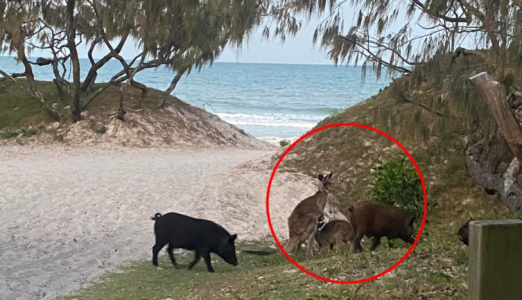An unbelievable outback video exposes a $300 million Aussie crisis—see the hidden scandal they didn't want you to know about!
By
- Replies 0
Australia's outback is facing a hidden crisis costing the nation a staggering $300 million, and the issue is far more severe than official figures suggest. The culprits? Feral pigs. These invasive animals are wreaking havoc across the country, and the situation has escalated to a point where hunters, farmers, and regional landowners are pleading for a more unified national response to tackle the problem.
The Australian Pig Doggers and Hunters Association (APDHA) President, Ned Makim, has revealed shocking statistics that starkly contrast government estimates. While official data pegs the feral pig population at around 3.5 million, hunters have already eradicated over four million feral pigs in 2024 alone. This discrepancy suggests that the true number of these pests could be as high as 40 or 50 million, a grossly underreported figure indicative of a much larger issue.
The impact of feral pigs on the Australian environment and economy is profound. They are prolific breeders and highly adaptable and intelligent, with a diet that includes virtually anything. This makes them a formidable force against native ecosystems and agricultural lands. They cause extensive damage by rooting and trampling vegetation, leading to soil erosion, waterway pollution, and the destruction of wetlands. This behaviour not only disrupts habitats for native plants and animals but also threatens Australia's biodiversity.
The damage in agriculture is equally devastating. Feral pigs can decimate crops, destroy fencing, and prey on young livestock such as lambs and sheep. They also pose a significant biosecurity risk by potentially spreading diseases like leptospirosis, brucellosis, and African swine fever, which could have catastrophic consequences for Australia's pork industry.
The APDHA has been at the forefront of this battle, with the Great Australian Pig Hunt seeing 4.86 million pigs killed by November this year at a cost of nearly $292 million. Makim suggests the country could benefit from a subsidised hunter's scheme to encourage more people to join the cause. He also advocates for recognising hunters' contributions and empowering them to do more, such as opening up more public land to manage hunting and considering payment for their efforts.
The problem is not confined to the bush; feral pigs are now encroaching on coastal areas and even beaches where they were previously unseen. Most management costs fall on individuals and families who engage in hunting, a cultural pursuit that demands ethical considerations. Makim emphasises the importance of humane treatment in the eradication process, as the animals deserve a humane death, which is both a moral obligation and a legal requirement in Australia.
This crisis calls for a more coordinated approach nationwide, as feral pigs do not recognise boundaries or borders. A national strategy is essential to manage the population effectively and mitigate the extensive damage caused by these animals.
Members of the Seniors Discount Club, this issue may seem distant, but it affects all Australians, from the food we eat to the environment we cherish. It reminds us of the delicate balance between nature and human activity and the need for responsible management of our natural resources.
 We invite you to share your thoughts and experiences on this topic. Have you encountered feral pigs in your area? What should be done to address this growing problem? Your insights are valuable; we can raise awareness of this underreported crisis together.
We invite you to share your thoughts and experiences on this topic. Have you encountered feral pigs in your area? What should be done to address this growing problem? Your insights are valuable; we can raise awareness of this underreported crisis together.
The Australian Pig Doggers and Hunters Association (APDHA) President, Ned Makim, has revealed shocking statistics that starkly contrast government estimates. While official data pegs the feral pig population at around 3.5 million, hunters have already eradicated over four million feral pigs in 2024 alone. This discrepancy suggests that the true number of these pests could be as high as 40 or 50 million, a grossly underreported figure indicative of a much larger issue.
The impact of feral pigs on the Australian environment and economy is profound. They are prolific breeders and highly adaptable and intelligent, with a diet that includes virtually anything. This makes them a formidable force against native ecosystems and agricultural lands. They cause extensive damage by rooting and trampling vegetation, leading to soil erosion, waterway pollution, and the destruction of wetlands. This behaviour not only disrupts habitats for native plants and animals but also threatens Australia's biodiversity.
The damage in agriculture is equally devastating. Feral pigs can decimate crops, destroy fencing, and prey on young livestock such as lambs and sheep. They also pose a significant biosecurity risk by potentially spreading diseases like leptospirosis, brucellosis, and African swine fever, which could have catastrophic consequences for Australia's pork industry.
The APDHA has been at the forefront of this battle, with the Great Australian Pig Hunt seeing 4.86 million pigs killed by November this year at a cost of nearly $292 million. Makim suggests the country could benefit from a subsidised hunter's scheme to encourage more people to join the cause. He also advocates for recognising hunters' contributions and empowering them to do more, such as opening up more public land to manage hunting and considering payment for their efforts.
The problem is not confined to the bush; feral pigs are now encroaching on coastal areas and even beaches where they were previously unseen. Most management costs fall on individuals and families who engage in hunting, a cultural pursuit that demands ethical considerations. Makim emphasises the importance of humane treatment in the eradication process, as the animals deserve a humane death, which is both a moral obligation and a legal requirement in Australia.
This crisis calls for a more coordinated approach nationwide, as feral pigs do not recognise boundaries or borders. A national strategy is essential to manage the population effectively and mitigate the extensive damage caused by these animals.
Members of the Seniors Discount Club, this issue may seem distant, but it affects all Australians, from the food we eat to the environment we cherish. It reminds us of the delicate balance between nature and human activity and the need for responsible management of our natural resources.
Key Takeaways
- The feral pig population in Australia is much larger than official government estimates, potentially as high as 40 to 50 million, according to the Australian Pig Doggers and Hunters Association (APDHA).
- Hunters have been a significant force in managing the feral pig population, with over four million pigs eradicated this year alone, an effort that some believe should be recognised and subsidised by the government.
- The environmental and agricultural damage caused by feral pigs is extensive, impacting native ecosystems, crops, and livestock and posing biosecurity risks through the potential spread of diseases.
- There is a call for a more nationalised approach to manage the feral pig problem and reduce the financial burden on local landowners and hunters, who currently bear the most management and eradication costs.








